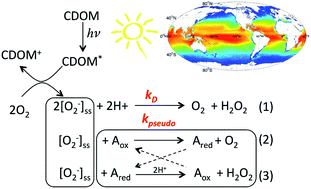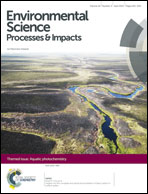Blending remote sensing data products to estimate photochemical production of hydrogen peroxide and superoxide in the surface ocean
Abstract
Hydrogen peroxide (H2O2) and its precursor, superoxide (O2−), are well-studied photochemical products that are pivotal in regulating redox transformations of trace metals and organic matter in the surface ocean. In attempts to understand the magnitude of both H2O2 and O2− photoproduction on a global scale, we implemented a model to calculate photochemical fluxes of these products from remotely sensed ocean color and modeled solar irradiances. We generated monthly climatologies for open ocean H2O2 photoproduction rates using an average apparent quantum yield (AQY) spectrum determined from laboratory irradiations of oligotrophic water collected in the Gulf of Alaska. Because the formation of H2O2 depends on secondary thermal reactions involving O2−, we also implemented a temperature correction for the H2O2 AQY using remotely sensed sea surface temperature and an Arrhenius relationship for H2O2 photoproduction. Daily photoproduction rates of H2O2 ranged from <1 to over 100 nM per day, amounting to ∼30 μM per year in highly productive regions. When production rates were calculated without the temperature correction, maximum daily rates were underestimated by 15–25%, highlighting the importance of including the temperature modification for H2O2 in these models. By making assumptions about the relationship between H2O2 and O2− photoproduction rates and O2− decay kinetics, we present a method for calculating midday O2− steady-state concentrations ([O2−]ss) in the open ocean. Estimated [O2−]ss ranged from 0.1–5 nM assuming biomolecular dismutation was the only sink for O2−, but were reduced to 0.1–290 pM when catalytic pathways were included. While the approach presented here provides the first global scale estimates of marine [O2−]ss from remote sensing, the potential of this model to quantify O2− photoproduction rates and [O2−]ss will not be fully realized until the mechanisms controlling O2− photoproduction and decay are better understood.

- This article is part of the themed collection: Aquatic photochemistry

 Please wait while we load your content...
Please wait while we load your content...